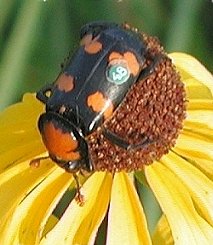
Burying beetles or sexton beetles, genus Nicrophorus, are the best-known members of the family Silphidae. Most of these beetles are black with red markings on the elytra (forewings). Burying beetles are true to their name—they bury the carcasses of small vertebrates such as birds and rodents as a food source for their larvae, this makes them carnivorous. They are unusual among insects in that both the male and female parents take care of the brood.
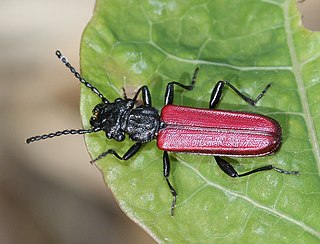
The Cucujidae, "flat bark beetles," are a family of distinctively flat beetles found worldwide under the bark of dead trees. The family has received considerable taxonomic attention in recent years and now consists of 70 species distributed in five genera. It was indicated Cucujus species are scavengers, only feeding on pupae and larvae of other insects and on other subcortical beetles such as their own. Since the Cucujidae prey on larvae of potentially tree damaging beetles that spread fungal diseases, they are considered to be beneficial to the health of living trees.

The family Mycteridae is a small group of tenebrionoid beetles with no vernacular common name, though recent authors have coined the name palm and flower beetles. The family Mycteridae is distributed worldwide. There are about 30 genera and 160 species in three subfamilies Mycterinae, Hemipeplinae and Lacconotinae (=Eurypinae). These 3 subfamilies are extremely diverse in appearance and are sometimes difficult to have a present diagnosis of the adults at the family level. About 20 species are found in Australia, species of three genera are found in North America The larvae are generally flattened and typically inhabit the spaces between leaves or the bases of fronds, where they appear to consume fungi.

The family Pythidae is a small group of tenebrionoid beetles with no vernacular common name, though recent authors have coined the name dead log bark beetles. There are seven genera, which are largely native to the mid-high latitude regions of the Northern Hemisphere and Australia, with one genus also present in the tropical Americas. The larvae are generally found with decaying vegetation and wood on which they feed, while adults are not associated with the larvae and are generally caught using malaise traps and light traps.

The Trictenotomidae are a small family of beetles in the superfamily Tenebrionoidea, containing fifteen species in two genera. Most species are found in the Oriental realm where they live in montane forest habitats. The family is considered, based on larval characters as well as sequence-based studies, to be closely related to the Salpingidae.

Pytho is a genus of dead log beetles in the family Pythidae. There are about nine described species in Pytho.
Atholus americanus is a species of clown beetle in the family Histeridae. It is found in North America, ranging from the eastern foothills of the Rocky Mountains to central Quebec, with its southern extents poorly known. It ranges in size from 2.7 to 4.2mm. This species is distinct from other members of Atholus because of its united 5th dorsal and sutural striations and the lack of any subhumeral striations.
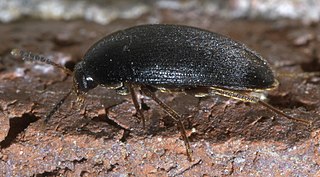
Eustrophopsis is a genus of polypore fungus beetles in the family Tetratomidae. There are about seven described species in Eustrophopsis.

Pseudoholostrophus is a genus of polypore fungus beetles in the family Tetratomidae. There are at least four described species in Pseudoholostrophus. Two of these described species are Nearctic.
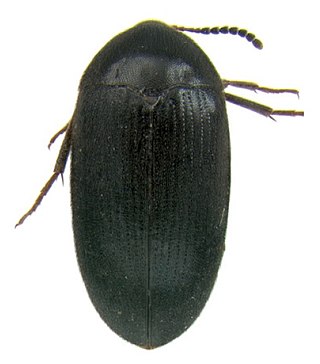
Synstrophus is a genus of polypore fungus beetles in the family Tetratomidae. There are at least two described species in Synstrophus.
Leptinus americanus is a species of round fungus beetle in the family Leiodidae. It is found in North America.
Sphalma is a genus of dead log beetles in the family Pythidae. There is one described species in Sphalma, S. quadricollis.

Eustrophus is a genus of polypore fungus beetles in the family Tetratomidae. There are at least two described species in Eustrophus.
Lacconotus is a genus of palm and flower beetles in the family Mycteridae. There are at least four described species in Lacconotus.
Pytho niger is a species of dead log beetle in the family Pythidae. It is found in North America.
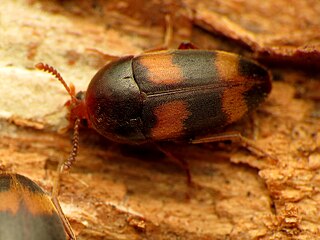
Holostrophus is a genus of polypore fungus beetles in the family Tetratomidae. There are seventeen described species in Holostrophus.
Myrmecoderus laevipennis is a species of narrow-waisted bark beetle in the family Salpingidae.
Myrmecoderus is a genus of narrow-waisted bark beetles in the family Salpingidae. There are at least three described species in Myrmecoderus.
Dacoderinae is a subfamily of narrow-waisted bark beetles in the family Salpingidae. There are at least 3 genera and about 11 described species in Dacoderinae.
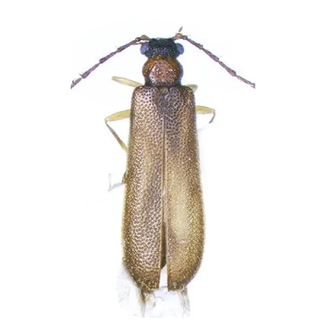
Binburrum articuno is a species of beetle which in the taxonomy field is classified under the genus Binburrum. It exists only in Australia. It is named after the fictional creature known as Articuno from the pop culture franchise Pokémon. It was named alongside other beetles from the same genus, Binburrum zapdos and Binburrum moltres, by Darren Pollock and Yun Hsiao. Because their names are based on a very popular franchise, these species saw above average media coverage upon being named.












